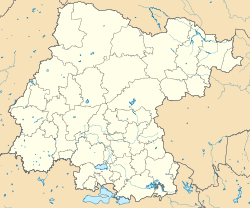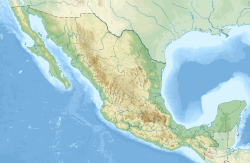Silao (Spanish pronunciation: [siˈlao]), officially Silao de la Victoria, is a city in the west-central part of the state of Guanajuato in Mexico. It is the seat of the municipality with the same name. As of the 2005 census, the city had a population of 66,485,[1][2] making it the seventh-largest city in the state. Silao is a center of agricultural and industrial activity.
Silao de la Victoria | |
|---|---|
City | |
 | |
| Nickname: Silao | |
| Coordinates: 20°56′52″N 101°25′41″W / 20.94778°N 101.42806°W | |
| Country | |
| State | Guanajuato |
| Founded | February 3, 1833 |
| Government | |
| • Mayor | Carlos García Villaseñor |
| Area | |
| • City | 12.1 km2 (4.7 sq mi) |
| • Municipality | 538.5 km2 (207.9 sq mi) |
| Elevation | 1,780 m (5,840 ft) |
| Population (2020 census)[1] | |
| • City | 83,352 |
| • Density | 6,900/km2 (18,000/sq mi) |
| • Municipality | 203,556 |
| • Municipality density | 380/km2 (980/sq mi) |
| Demonym | silaoense |
| Time zone | UTC-6 (CST) |
| Mexican Postal Code | 36100 |
| Area code | 472 |
| Website | http://www.silao.gob.mx |
Airport
editThis city is served by the Del Bajío International Airport. It functions as the central airport for the cities of Irapuato, Guanajuato, León, Salamanca and San Miguel de Allende.
Toponymy
editIn its original Otomi language, the area was called Tsinäkua by both the Otomi and Purépecha natives. In the Otomi language its name Tsinäkua means 'place of dense fog,' as a result of the columns of water vapor rising from thermal springs in the area of Comanjilla. The name evolved to 'Sinaua', 'Silagua' and finally 'Silao' after the Spanish conquest of the region.
History
editIn the place where Silao now sits, there was an Otomí settlement that was conquered by the Purépecha empire. The name of the area remained Tsinäkua under Purepecha rule. The name evolved to 'Sinaua', 'Silagua' and finally 'Silao' after the region was later conquered by Spain.
Geography
editSilao is located in the Mexican state of Guanajuato. It is situated 100° 25´ 59´´ longitude west of the Greenwich meridian and 20° 56' 24 latitude north. Its altitude is 1,780 meters above sea level.
The municipality of Silao has an area of 538.5 km2, equivalent to 1.76% of the total state area. The city of Guanajuato lies to the east and north of Silao; to the south lies Irapuato; to the west is Romita; to the northwest is León.
Geology
editThe territory of Silao is almost planar formed in by the Bajío, between its few important elevations, one can find the 'Cerro del Cubilete' whose altitude is 2,570 meters above sea level and is considered the geographic center of the country.
Hydrography
editThe Silao River, crosses the major part of the municipal territory. It is fed by the Magueyes, Pascuales, Hondo, and Tigre streams, as well as the Gigante River, which is its major tributary. Within the municipality are some streams of importance, like those of the Agua Zarca, San Francisco, El Paraíso, Pabileros, and Aguas Buenas.
Climate
editThe climate of the city is semi-arid in the majority of the territory, with rains in the summer and an average annual temperature of 28 °C. Temperatures can rise as high as 34 °C in the month of June, and a minimum of 0 °C has been reached in the months of December and January. However, in the northeastern zone the climate varies to semi-dry with a temperature predominantly in excess of 28 °C. Precipitation varies between 600 and 800 millimeters per year.
Economy
editSilao is a center of agricultural and industrial activity in the area, with a wide variety of farm crops, produce and dairy packing plants. A General Motors truck and SUV assembly plant which as of 2016 makes one third[3] of Chevrolet and GMC Full-size Pickups.[4] Volkswagen has an engine plant,[5] and Pirelli makes tires.[6]
Population
editAccording to the results presented by the second 'Conteo de Población y Vivienda' (census) of 2005, the municipality counts a total of 147,123 inhabitants.
Ethnic groups
editThe indigenous population of Silao is limited to 203 inhabitants that represent 0.15% of the total municipal population. The principal native languages are Mazahua and Nahuatl.
According to the second 'Conteo de Población y Vivienda' (Census) of 2005, there are a total of 187 persons who speak some indigenous language.
The municipality has a density of 250 persons per square kilometer and an average population increase of 1.6%.
Religion
edit95.8% of the population of Silao (as of 2000) are Roman Catholic. Approximately 1.8% are Protestants and Evangelicals, and 1.4% are other religions. The last 1% either stated they don't have a religion or it wasn't specified.
Historic Monuments
edit- Parroquia de Santiago Apóstol, construction was started in the end of the 17th century and ended in the year 1728. Its style is neo-classical.
- Templo del Santuario, constructed at the end of the 17th century.
- Templo de la Casa de Ejercicios, built in 1834.
- Palacio Municipal, formerly functioned as city jail and headquarters.
- Mercado González Ortega, main market in Silao.
- Monument to Cristo Rey (Christ the King), started construction on December 10, 1945, and completed on August 17, 1949. The monument itself stands 20 meters from foot to head and is in the 'cerro del Cubilete', which is considered the geographic center of the country of Mexico.
- Casa de Mauricio Ruiz, historic house, home of the Mexican artist Mauricio Ruiz Chávez
Tourist attractions
editSome of the attractions in Silao are:
- Here one can find the Cerro del Cubilete, considered by some to be the geographic center of the country.[7] In the highest part of the mountain (at 2,500 meters) stands a monument to Cristo Rey or Christ the King. It represents the unity of the people of México in the Catholic faith. The Bajio region was the center of the Catholic insurgency in the Cristero War, whose battle cry was "¡Viva Cristo el Rey!". Construction started on December 10, 1945, and was completed on August 17, 1949. The monument itself measures 20 meters from its feet to its head. Its location dominates the scenery of the 'Bajío' region surrounding Silao.
- Museum of the Chávez Morado Brothers (muralists and sculptors).
- Silao has 27 parochial churches and innumerable buildings rich in architecture and history.
- Building of the 'Casa de la Cultura' (House of Culture), previously the military quarters of Silao.
Silao is also central to other cities and towns of interest to tourists. The cities of Guanajuato and Romita are approximately 25 minutes by highway. León and Irapuato are about 35 minutes by highway.
Business district
editThis District is located at Guanajuato Puerto Interior The business district is development at this time. This District is designed to lodge: hotels, financial and commercial buildings
References
edit- ^ a b Citypopulation.de Population of Silao de la Victoria municipality with localities
- ^ "Principales resultados por localidad 2005 (ITER)". INEGI: Instituto Nacional de Estadística, Geografía e Informática. 2007. Archived from the original on June 13, 2011. Retrieved July 30, 2007.
- ^ Bill Vlasic (February 13, 2017). "Profitable Pickups May Be in Cross Hairs of Trump Border Tax". The New York Times. Retrieved February 14, 2017.
Industry analysts estimate that one-third of G.M.'s annual pickup production comes from its sprawling assembly plant in Silao, Mexico.
- ^ "GM Global Operations Mexico Silao Assembly". gm.com. 2007. Archived from the original on August 14, 2007. Retrieved July 30, 2007.
- ^ Ludwig, Christopher (July 14, 2016). "Volkswagen & Audi in Mexico part 1: Sharing logistics in a state of expansion". Automotive Logistics. Retrieved May 13, 2017.
- ^ Ludwig, Christopher (May 24, 2016). "Supply Chain Conference: Mexican and intermodal shockwaves". Automotive Logistics. Retrieved May 13, 2017.
- ^ Tony Burton. "Did you know? Mexico has more than one geographic center".
External links
edit- Official website of the commerce of Silao, Guanajuato (Español)
- Ayuntamiento de Silao Official website of the municipality of Silao (Español)
- Guanajuato Encyclopedia of the Municipalities of Mexico (Español)
- Official website of the municipality of Silao, Guanajuato (Español)
- Periodico de Sociales Gente&Stilo de Silao, Guanajuato (Español)
- Órgano Colegiado de Educación Media Superior & Superior de Silao, Guanajuato (Español)
- Enciclopedia de los Munincipios de Guanajuato (Español)


